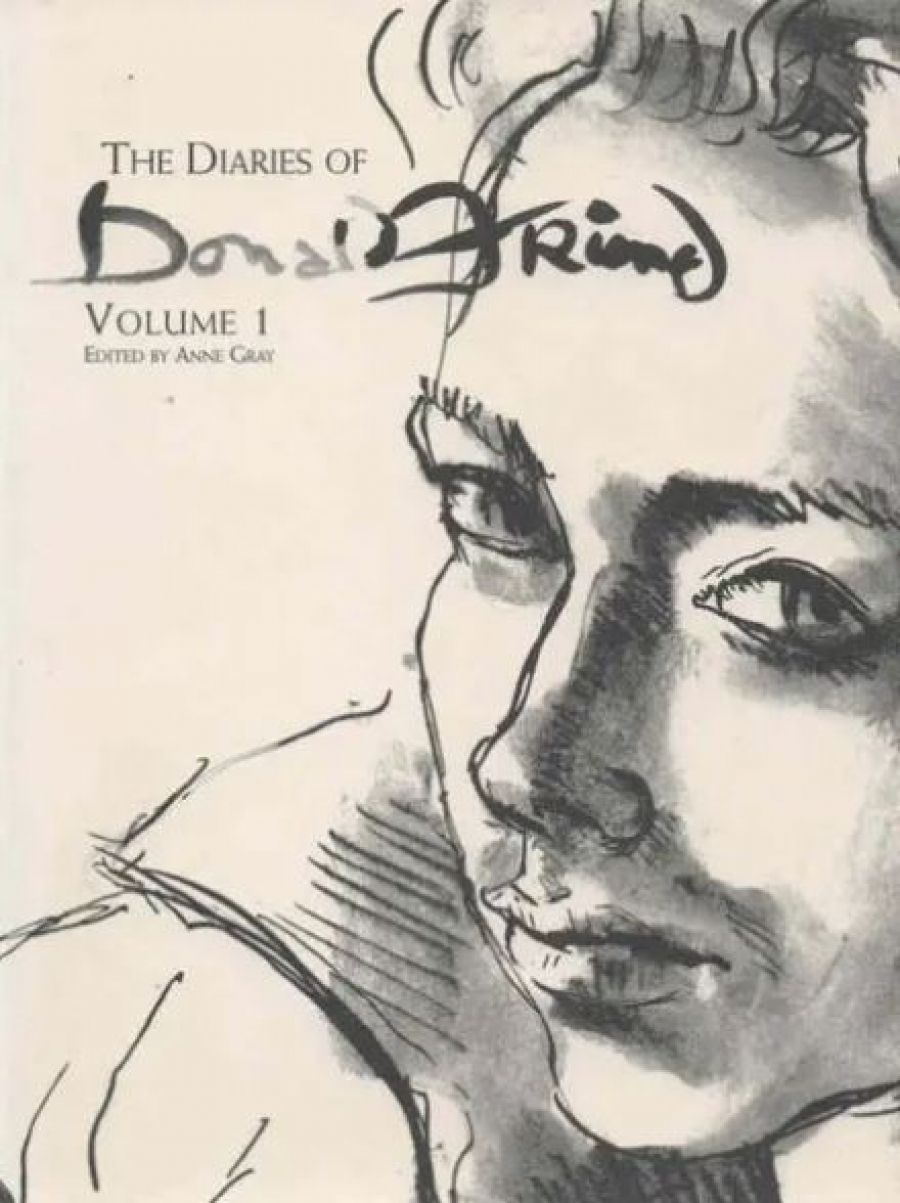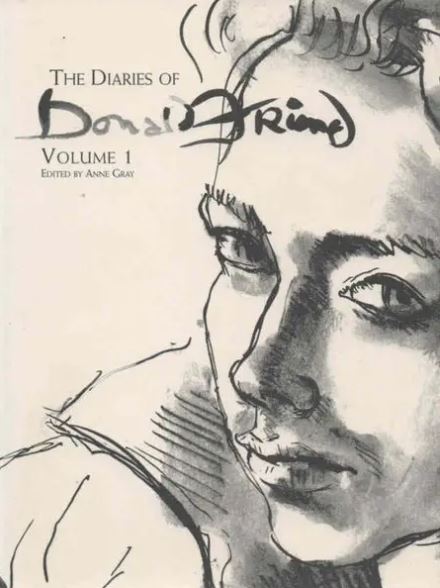
- Free Article: No
- Contents Category: Non-fiction
- Custom Article Title: Donald Friend's Theatre of Self
- Review Article: Yes
- Article Title: Donald Friend's Theatre of Self
- Online Only: No
- Custom Highlight Text:
'It is simply a very young girl’s record of her own thoughts and impressions, and consequently meant for publication.’ Oscar Wilde’s Cecily, in The Importance of Being Earnest, expresses the contradictions of many diarists. Whether by chance, or by the diarist’s own wish, this most private form of writing often comes before the public. It may be that in the diary’s purest form the self communes with the solitary self. Yet many of the great diarists have a strong sense of audience. Writing a diary is a means of exploring the self, but it is also a way of testing voices, trying on masks. This element of theatre is very strong in the diaries of Donald Friend.
- Book 1 Title: The Diaries of Donald Friend
- Book 1 Subtitle: Volume 1
- Book 1 Biblio: National Library of Australia, $49.95hb, 541pp, 0 642 10738 6
- Book 1 Cover Small (400 x 600):
- Book 1 Cover (800 x 1200):
The first diary entry was written just before Donald’s fourteenth birthday. Described as ‘a writing down of my own personal thoughts’, this volume carries the ritual warning that intrusive readers will get what they deserve in unflattering versions of themselves. Yet, like most introspective adolescents, Donald is preoccupied with his own performance: there is not much close observation of others. His mother, whom he calls ‘l’Adorable’, is idealised for her beauty, wit and ‘perfect taste’, but the diary gives little sense of her personality. His remote and disagreeable father is more vividly evoked: ‘Dad who has no character and dresses in plain suit, brown shoes, countryman’s hat, white shirt, black tie, greeted me, not having seen me for over six years, with “Hallo, Don, how are yer?”.’
When these mismatched parents were eventually divorced, it was a relief for Donald, who knew that he could never please his father. Holidays on the family’s property, near Moree, New South Wales, are dramatised as descents into hell from which Donald returns to Sydney with relief as well as delight in the books and music, films and theatre, which are central to his mother’s leisured urban world. He announces: ‘Have done quite a lot of painting lately, and have made up my mind that I shall be an artist. And I shall be famous.’
The first years of Donald Friend’s diaries reflect an uncertain self. He likes to shock, but is equally anxious to please. School routine ‘provides a straw for a rather drowned me to cling to’, but he cannot resist the drama of escape. ‘I adore leaving schools,’ he writes, as he plans his exit from Sydney Grammar. His dislike of outback life, which he identifies with his father, is qualified by love of the landscape; and his accounts of riding, swimming and exploring the bush, as well as his obvious competence in station work, suggest that he is more at home at his father’s property than he will admit.
Studying with Sydney Long, and later with Dattilo-Rubbo, Friend gained confidence in his ability to make a life as an artist. With a small allowance from his father, he was able to travel within Australia and, later, with his grandmother’s help, he went to London, studied at the Westminster School, exhibited his work, and met Ladipo, a Nigerian from Ikerre, who became his model and lover. When World War II broke out, Friend was living in Ikerre as a guest of the ruler. News of Europe reached him in vague and muffled form. Although he returned to Australia in 1940, it was to claim an inheritance, not to enlist. He did not join the army until May 1942, after Japanese submarines in Sydney Harbour made the threat to Australia real and immediate.
Between leaving school in 1931 and enlisting in 1942, Friend did not keep a diary. It seems paradoxical that these years of rich emotional and cultural experience are less well-documented than his dreary and circumscribed time in the army. His war diaries contain no battle scenes; he never served outside Australia, and his worst enemy was boredom. The diaries begin in June 1942, at Hume Camp, outside Albury, where Friend trained as a gunner. Untroubled by the physical hardships, he felt ‘the complete absence of intellectual companionship’. His army diaries seem not so much to record a life as to create one.
Unlike the mock-heroic prose of the very young Donald, sprinkled with archaisms like ‘verily’ and ‘methinks’, the accounts of life in camp and the rituals of training are tough and spare, often mercilessly so. A bleak account of an army funeral recalls Henry Lawson’s ‘The Union Buries Its Dead’. Elsewhere, the painter’s vision discerns and celebrates the landscape in all its moods.
Deprived of the means to paint, Friend went out scavenging the sites of unfinished army huts to find pieces of ply-wood. Waiting for paints to be sent from Sydney, he wrote with sensuous longing for their colours and textures. He always hoped that his gifts as an artist would be used, but he was asked only to design Christmas cards and stage sets for his unit - even a tea cosy. He hoped for a transfer to Intelligence but, when his chance came, he failed the examination. He volunteered as a guinea pig in a malaria experiment and endured terrifying dreams in a ‘panic sub-world’ of hospital. Belatedly, in 1945, he was appointed an official war artist.
He lived for rare interludes on leave in Sydney, but these often ended in sadness: ‘I don’t often love. I wish I never did ... Friendship is the only safe and deep thing I have.’ His homosexuality must have deepened his isolation in the all-male army group. The diaries stress his need to maintain ‘the outer defences of mental privacy’ among men he despised. Yet his sense of intellectual and social superiority, so arrogantly expressed in his writing, is belied by the gentleness of the sketches of his companions that illustrate the diaries.
‘My best [writing] is in bitterness,’ Friend said, and it may be true that he did not easily use the language of love. When he wrote about painting, he allowed passion to break through:
I love the sensation of [painting] like nothing else ... all that part of my life spent away from it is like a dream, a daze ... I do my duties mechanically, with all my consciousness focussed on such problems as the colour of a tent, the shape of a rock … in their relation to certain visions of colour stored in the mind.
Friend’s vocation as an artist was never in doubt. In the army, boredom and isolation made him a wonderfully eloquent diarist. With three more volumes yet to be published, Donald Friend’s theatre of the self is assured of a fascinated audience for years to come.



Comments powered by CComment